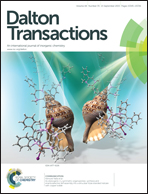Structural classification of metal complexes with three-coordinate centres†
Abstract
Attempts to describe the geometry about three-coordinate silver(I) complexes have proven difficult because interatomic angles generally vary wildly and there is no adequate or readily available classification system found in the literature. A search of the Cambridge Structural Database shows that complexes formed between any metal centre and three non-metal donors (18 001 examples) usually adopt geometries that are quite different than ideal ‘textbook’ extremes of either trigonal planar (∼4% with α = β = γ = 120 ± 2°), T-shaped (∼0.05% with α = 180 ± 2°, β = γ = 90 ± 2°), or trigonal pyramidal (∼0.3% with α = β = γ = 110 ± 2°). Moreover, there are multiple variations of “Y-type” and “other” shapes that require elaboration. Thus, to assist in future structural descriptions, we developed a classification system that spans all known and yet-to-be-discovered three-coordinate geometries. A spreadsheet has also been constructed that utilizes the “shape-space” approach to extract the structural description from a user input of three angles about a tri-coordinate centre and the number of atoms in a plane. The structures of two silver(I) complexes of new N-donor ligands p-NH2C6H4C6H4CH(pz = pyrazol-1-yl)2, L1, and 2-ferrocenyl-4,5-di(2-pyridyl)imidazole, L2, illustrate the utility of this classification system.


 Please wait while we load your content...
Please wait while we load your content...